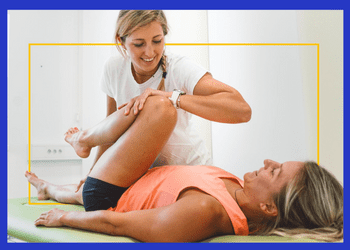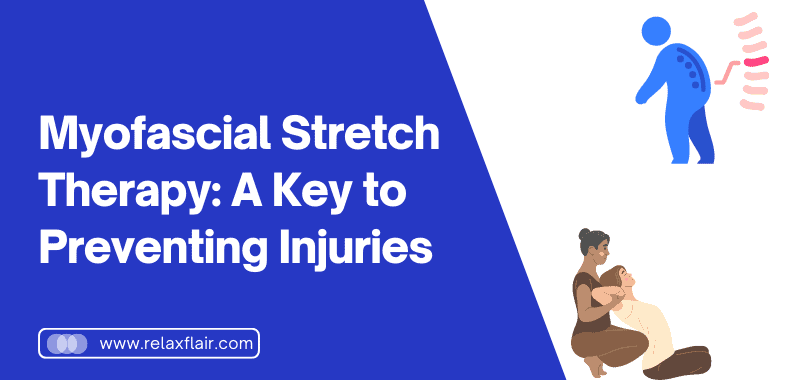Muscles that are too tight can expose athletes and active individuals to a greater risk of injury. Myofascial stretch therapy is an effective strategy for addressing this issue and decreasing the chances of muscle strain, pulls, or other harm. This technique works by loosening up muscles so they become more supple and flexible, thus mitigating the likelihood of any physical trauma.
Myofascial stretch therapy is an effective way to help eliminate muscle tightness and boost flexibility, range of motion, and injury prevention. Through targeting the fascia – connective tissue that supports muscles – this form of therapy offers athletes and active individuals a multitude of advantages.
Massage chairs are a great option for those wishing to incorporate stretching into their self-care routine. These seating solutions come equipped with integrated stretches that can help increase flexibility, enhance range of motion, and reduce muscle tension without having to put in the extra time it would take at a gym or studio.
In this article, we will discuss why muscle tension can be so detrimental for athletes, as well as highlight the benefits associated with myofascial stretch therapy.
What is Myofascial Stretch Therapy?
Myofascial stretch therapy is a type of stretching that targets the fascia, the connective tissue that surrounds and supports muscles. Unlike traditional stretching, which focuses solely on muscles, myofascial stretch therapy takes a more holistic approach, targeting both the muscles and the fascia.
Many massage chairs offer a variety of stretching techniques in addition to massage functions, making them a convenient and effective option for incorporating stretching into your self-care routine. These stretching techniques can help to improve flexibility, increase range of motion, and reduce muscle tension, contributing to overall wellness and injury prevention.
 Some of the key differences between myofascial stretch therapy and other forms of stretching include:
Some of the key differences between myofascial stretch therapy and other forms of stretching include:
- Focus on the fascia: MST targets the fascia, which can help to improve overall mobility and reduce muscle tension. Traditional stretching, on the other hand, focuses primarily on the muscles.
- Longer holds: In myofascial stretch therapy, stretches are held for longer periods of time, often up to several minutes. This allows for a deeper stretch and can help to increase flexibility over time.
- Gentle pressure: MST typically involves gentle, sustained pressure rather than forceful stretching. This can help to avoid injury and minimize discomfort.
- Personalized approach: Myofascial stretch therapy can be tailored to individual needs, taking into account factors such as fitness level, injury history, and flexibility goals.
There are many potential benefits of myofascial stretch therapy, particularly when it comes to injury prevention. Some of these benefits include:
- Improved flexibility: Myofascial stretch therapy can help to increase the range of motion and improve overall flexibility, reducing the risk of muscle strains and other injuries.
- Reduced muscle tension: By targeting the fascia, myofascial stretch therapy can help to release tension in the muscles, reducing the risk of injury and improving overall comfort.
- Improved posture: Tight muscles and fascia can contribute to poor posture, which can increase the risk of injury over time. Myofascial stretch therapy can help to improve posture and reduce the risk of injury.
- Enhanced athletic performance: Improved flexibility and reduced muscle tension can both contribute to better athletic performance, making myofascial stretch therapy a valuable tool for athletes.
Overall, myofascial stretch therapy is a versatile and effective technique for improving flexibility, reducing muscle tension, and preventing injury. Whether you are an athlete looking to enhance your performance or simply someone looking to improve your overall mobility and comfort, myofascial stretch therapy can be a valuable addition to your self-care routine.
Common Injuries and Their Causes
Athletes and active individuals are often susceptible to injuries, which can range from minor strains to more severe issues such as broken bones or torn ligaments. Some of the most common injuries include:
- Sprains and strains: These types of injuries occur when ligaments or muscles are stretched or torn. They can be caused by sudden movements or overuse and can result in pain, swelling, and limited mobility.
- Tendinitis: Tendinitis is a condition that occurs when tendons become inflamed or irritated, often due to overuse. It can result in pain, stiffness, and limited mobility.
- Shin splints: Shin splints are a common injury among runners and other athletes, and occur when the muscles and tendons in the shin become overworked. They can result in pain, swelling, and tenderness in the lower leg.
- Stress fractures: Stress fractures occur when small cracks develop in bones due to overuse. They are common among runners and other athletes who engage in repetitive impact activities.
Limited flexibility, range of motion, and an inability to cope with sudden movements can all result from muscle tightness. Such symptoms make it exceedingly difficult for the body to absorb shock or adjust quickly in certain scenarios; as a result, strains and sprains can occur more frequently. By loosening muscles and fascia, the risk of these injuries is considerably reduced due to improved agility when moving.
Professional athletes, such as basketball players with sprained ankles, runners with shin splints and stress fractures, and tennis players struggling with elbow tendinitis are all prime examples of individuals who have been impacted by muscle tightness. To help protect them from further pain or harm while also improving their performance levels in the long run – it’s essential to address any muscular imbalances by increasing flexibility.
How Myofascial Stretch Therapy Prevents Injuries
One of the key ways that myofascial stretch therapy prevents injuries is by addressing muscle tightness. A limited range of motion due to tight muscles and fascia can make it more challenging for your body to quickly adjust or absorb sudden movements. By engaging in myofascial stretch therapy, consisting of specific stretching techniques to reduce tension and enhance flexibility, you may be able to decrease the risk of injury while enhancing overall function.
Regular myofascial stretch therapy can offer numerous benefits for athletes and active individuals, including:
- Improved flexibility: MST helps athletes maximize their range of motion and reduce muscle strain, ultimately minimizing the danger of injury while improving overall performance.
- Reduced risk of injury: MST therapy can help prevent strains, sprains, and other injuries by loosening tight muscles and increasing flexibility.
- Enhanced recovery: MST can help to speed up recovery time by improving circulation, reducing muscle soreness, and enhancing overall tissue health.
 Myofascial stretch therapy has been a great asset to athletes of all levels, helping them reduce their chances of injury and improve their overall performance.
Myofascial stretch therapy has been a great asset to athletes of all levels, helping them reduce their chances of injury and improve their overall performance.
For instance, professional football players have seen the power of adding myofascial stretch therapy as part of their regular training regimen; easing concerns about strains and sprains. Similarly, runners have noticed a decrease in shin splints or other overuse injuries by scheduling regular sessions with this type of stretching technique.
Drawbacks of Myofascial Stretch Therapy
- Can be uncomfortable or painful for some individuals
- Requires a trained professional to perform correctly
- May not be suitable for individuals with certain medical conditions
- Can be expensive, particularly for frequent sessions
Myofascial stretching therapy can yield outstanding results for athletes, however, incorporating stretching techniques into their recovery routine with massage chairs will take those benefits to a whole new level. Many of these massage chairs come equipped with programs that focus on specific muscle groups, allowing the athlete to experience improved flexibility and decreased muscle tension in an effortless and soothing atmosphere.
| Drawbacks of Using Massage Chairs for Myofascial Stretch Therapy |
|---|
| Limited range of motion compared to manual stretching techniques |
| May not be as effective at targeting specific areas of the body |
| The quality and effectiveness of the stretching feature can vary between different models |
| Massage chairs can be expensive, particularly those with advanced stretching features |
Myofascial stretch therapy is an indispensable tool when it comes to preventing injuries and improving athletic performance. With its ability to address muscular tightness and increase flexibility, the benefits of this therapy are many; efficient movement patterns combined with decreased injury risks lead to improved health overall – ideal for active individuals or athletes.
Techniques for Myofascial Stretch Therapy
There are several techniques that can be used in myofascial stretch therapy to address muscle tightness and improve flexibility. Here is an overview of some of the most commonly used techniques:
| Technique | Description |
|---|---|
| Foam rolling | Foam rolling involves using a foam roller to apply pressure to tight or sore muscles, helping to release tension and improve circulation. |
| Static stretching | Static stretching involves holding a stretch for a set period of time, allowing the muscle to gradually lengthen and improve flexibility. |
| Dynamic stretching | Dynamic stretching involves moving through a range of motion with control and purpose, helping to warm up the muscles and improve overall flexibility. |
Foam rolling can be an excellent way to prepare your muscles for exercise and aid in post-workout recovery. This technique is especially beneficial for targeting trigger points as well as tension in areas like the back, glutes, and hips.
MST often incorporates static stretching to augment flexibility and range of motion. This technique encompasses holding a given position for 20-30 seconds or longer, allowing the muscle fibers time to relax and grow more extended. Static stretching is particularly beneficial after an exercise session or as part of a regular stretching routine— both are used in order to ward off injury while enhancing performance.
Movements that are steady and intentional make up dynamic stretching which serves well as a pre-workout warm-up, enabling the muscles to be ready for action. This technique can also stand alone in improving general flexibility and locomotion prowess.
To enhance the effectiveness of myofascial stretch therapy, specialized massage, and manual techniques are used to release tension and promote healing in tissue. This kind of personalized care is designed to fulfill each person’s individual needs while achieving maximum results.
FAQs:
Does Fascial Stretch Therapy Work?
Yes, fascial stretch therapy has been shown to be effective in improving flexibility, reducing pain, and enhancing overall performance. Studies have evidenced that this type of therapy has the potential to widen the range of motion, lessen muscle aches, and enhance athletic performance in a variety of sports.
A recent report in the Journal of Sports Science and Medicine showed that just a single session of fascial stretch therapy could effectively expand hamstring flexibility among soccer players. Even though more research is needed to get an accurate understanding of the advantages that come from this particular method, there has been evidence emerging that shows its usefulness when it comes to enhancing sports performance and decreasing chances for injuries.
What is the Difference Between Myofascial Stretch Therapy and Regular Stretching?
While both involve lengthening the muscles and increasing flexibility, there are some key differences between the two techniques. Regular stretching typically involves holding a stretch for a certain period of time, while Myofascial Stretch Therapy involves more active movements that are designed to target specific areas of tightness and tension in the muscles and connective tissues.
Additionally, MST often involves the use of tools such as foam rollers or massage balls to apply pressure to these areas, which can help to release knots and promote greater flexibility. Ultimately, while both techniques can be effective in improving flexibility and preventing injury, MST offers a more targeted and active approach that may be particularly beneficial for athletes and individuals with chronic muscle tightness or pain.
Final Words
In conclusion, incorporating Myofascial Stretch Therapy into your regular workout routine can be an effective way to prevent injuries, improve flexibility, and enhance overall athletic performance. This method of targeting muscle tightness and tension can help to loosen knots, resulting in improved mobility which greatly lessens the chances of injury while engaging in physical activity.
Massage chair with MST technology has come together to make it easier than ever before to take advantage of regular stretching and massages in the comfort of your own home. Incorporate this helpful technique into your daily routine today, reap its benefits, and enjoy a greater sense of well-being.
If you’re interested in trying Myofascial Stretch Therapy, it’s important to work with a trained professional who can help you to develop a safe and effective stretching routine that is tailored to your individual needs and fitness goals. Whether you’re a professional athlete or simply looking to stay active and healthy, incorporating this technique into your regular workout routine can help you to achieve greater flexibility, mobility, and overall wellness. So why not give it a try today?
